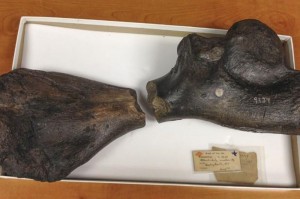

The turtle lived between 70 and 75 million years ago during the Cretaceous Period, and the fragment of the bone that was discovered first was assumed by scientists to be from Burlington County, N.J. It is unknown when this fragment was found, though the records of the fossil in the Academy’s collection date back to 1849. No other fossils of the species or of its genus have been found.
In the fall of 2012, however, Gregory Harpel, an analytical chemist and amateur paleontologist, visited a stream in Monmouth County, N.J. He often visited the area to look for fossilized shark teeth. While there, Harpel spotted a rock on a grassy bank near the brook. Upon examining it further, he noticed what looked like teeth marks from sharks. He brought the object to the New Jersey State Museum in Trenton, where David Parris, the museum’s curator of natural history, identified the fossil.
“I was just sitting at my desk, and I wasn’t paying much attention,” Jason Schein, assistant curator of natural history at the New Jersey State Museum, said, because fossils are brought in frequently. He said that the amateur paleontologists usually find shell pieces, but they come in with dinosaur bones a few times a year.
Schein became intrigued, however, when Parris became uncharacteristically excited by Harpel’s finding. Parris was familiar with the Academy’s collection, so he jokingly suggested to Schein that the fragment matched the piece at the Academy. Parris and Schein continued to assert that it was just half a bone.
Still, Schein brought the fossil to the Academy a few months later when he visited for a different purpose. He and the other paleontologists quickly realized that the seemingly impossible had occurred. Harpel’s find was the proximal end of the humerus, or the end closer to the shoulder. They tried turning the fossil around to prove that the pieces did not match, but to no avail.
The fossil’s two-part discovery has significant implications for paleontology. One important aspect of the find is the delayed finding of the fossil. Ted Daeschler, an associate professor in the Department of Biodiversity, Earth and Environmental Science as well as an associate curator of vertebrate zoology at the Academy, said that the group checked official records for a unique find like this, but they could not find any.
The fossil also affects what paleontologists know about the durability of fossils. “The vast majority of fossils that are in the ground are never found because they are eroded,” Schein said.
According to Daeschler, fossils can erode after months of exposure due to factors such as freezing and thawing. “It’s not uncommon when you find fossils to find lots of bone fragments,” he said. “I’m sure it wasn’t exposed to the weather all that time.”
He said that the scientists are not sure how long the bone was exposed. “[We assume that] it was a complete bone when it was buried. As the soft sediments eroded away, part of the bone was exposed and broke away.” He noted, however, that this fragment may have been exposed in the past and then recovered in the soft sand, perhaps when the original piece was found.
A report on the find will appear in the next issue of “Proceedings of the Academy of Natural Sciences of Philadelphia.” The discovery is also mentioned in the April 2014 issue of National Geographic magazine.

